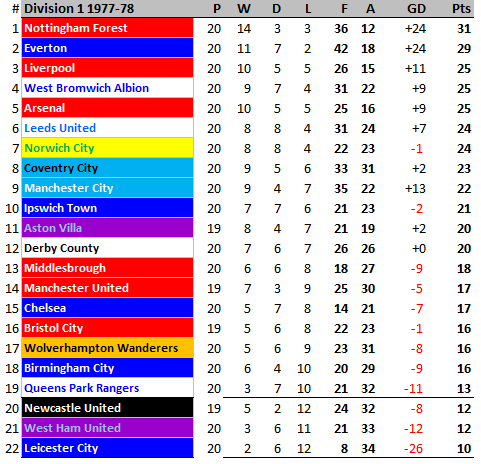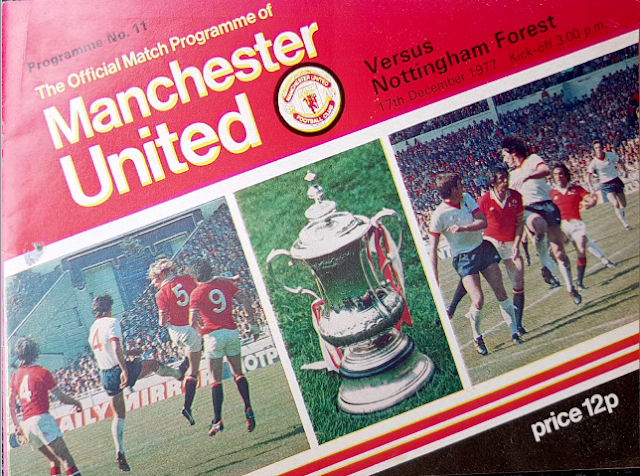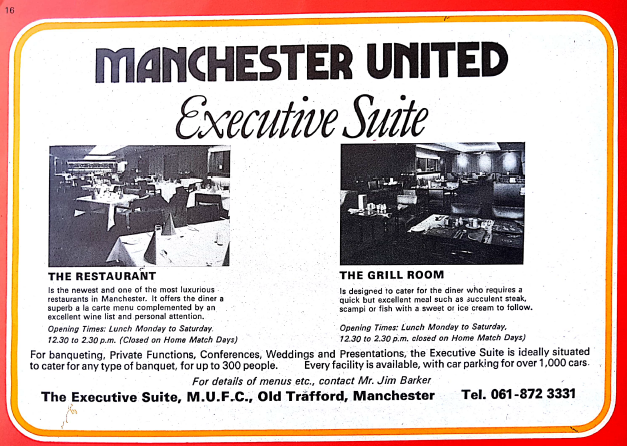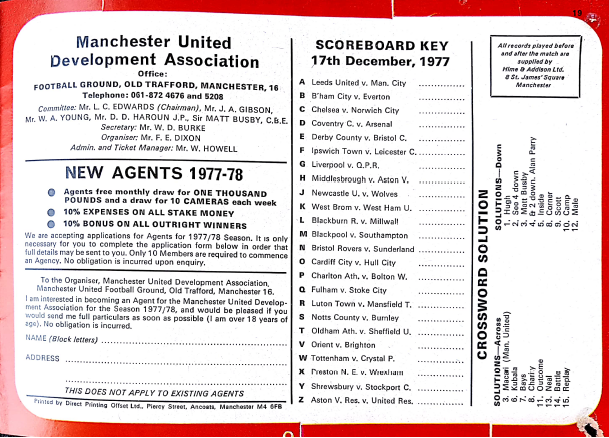Things were tightening up at the top of the First Division 40 years ago. Everton had gone 17 games unbeaten and were closing the gap on Forest who had been top of the league for over two months. Forest beat Coventry City 2-1 last week to keep Everton one point behind but now faced a very tricky away match at the so-called "theatre of dreams" - Manchester United's Old Trafford, whilst Everton had a much easier looking fixture away at Birmingham. Could this be the day Forest lost their lead at the top? You know the answer...
Forest would put in one of their most famous performances of the championship winning season, thrashing United 4-0 away to complete the double over them after beating them 2-1 at home just 35 days earlier. More on that later, but first, a quick look at the history of Old Trafford.
I covered this last time, but here's the Forest v Man U historic chart again - from a different angle. It still looks bad for Forest!
Bizarrely, I also watched Wolves play Grimsby in a cup-tie on neutral ground when they played a League Cup Quarter final second replay at Derby's ram-shackled Baseball Ground in 1979. Wolves won that one too, 2-0. It would be the season they played Forest at Wembley and beat us. I'll cover that one later. The most notable thing I remember from that night is the Wolves fans taunting the Grimsby followers with "You only sing when you're fishing!"
Old Trafford was the target of bombing by the Germans in the war.
And, of course, it was Old Trafford that hosted the F.A. Cup final replay between Chelsea and Leeds United in 1970.
In the days before the new Wembley stadium was finished in 2008, Old Trafford regularly hosted one of the F. A. Cup semi finals, although it hadn't done so in the previous three seasons and wouldn't do so again until 1989.
This was my second visit to Old Trafford, having been there to watch Manchester United beat Oxford 4-0 in the F. A. Cup 3rd round in January 1976.
We went on the "Forestrail" service, with a bit of trepidation because earlier in the season the rumours were going around that Manchester United fans had ambushed Chelsea supporters after the match on the way back to the station and a lot of people had been injured.
In the second half Forest dominated and stretched their lead to 3-0 on 53 minutes when Gemmill broke free in one of his characteristic darting runs before laying on the perfect pass to Robbo who slotted coolly past Paddy Roche. Forest capped off a great win with another Woodcock effort in the 89th minute with Gemmill again the architect.
I remember feeling a little apprehensive about beating them so convincingly in their own back yard. If Chelsea fans had been attacked after beating United 1-0, what would they do to us!? Nothing. We were kept in the ground for a few minutes to allow United fans to leave and then when we were let out the streets were relatively bare.
The press reaction summed up a general feeling in the country. This Forest team were not at the top of the league by a fluke, they were genuinely going for the title on merit. This was a turning point. From now on many neutral fans started to think not only that Forest could win the league, but that they should.
Read this report in the following Monday's Guardian to see what I mean...
I love that... "Then, the slightly shocking truth began to dawn that United really had no right to be occupying the same pitch as Forest."
It was good day for Forest elsewhere too. Crucially, Everton slipped up at Birmingham, only getting a draw, so Forest stretched their lead back to two points and improved their goal difference at the same time. We now had the same goal difference as they did.
Most of the others in the chasing pack won though, so we weren't getting too cocky.
The win also put Forest back in the top 3 on current form. With Everton slipping up against out-of-form Birmingham, it meant Leeds were the new "form" team. Newcastle won again and so put some real pressure on QPR, now without David Needham in their defence.
So, for a change, Bob Latchford didn't score and with Tony Woodcock getting a couple, he made his first appearance in the First Division's top scoring charts and was starting to catch up with his team mate Peter Withe who hadn't scored a league goal now in nine games.
In other news, Forest fans were relieved and disappointed at the same time as the F. A. decided to appoint Ron Greenwood, and not Brian Clough, as the new England manager.
It was also F.A. Cup 2nd Round day and of interest to us would turn out to be a match going on at the County Ground, where Swindon Town beat Brentford 2-1 to clinch a place in the 3rd round - and a visit to the City Ground in January.
Before that, though, it was Christmas Day and the very appetising looking Boxing Day Fixture at home to Liverpool followed, two days later, with a trip up north to in-form Newcastle United. So having played United for the second time, the next two games would complete at least one fixture with all 21 other First Division teams. Nobody could argue Forest had been lucky then.
Forest would put in one of their most famous performances of the championship winning season, thrashing United 4-0 away to complete the double over them after beating them 2-1 at home just 35 days earlier. More on that later, but first, a quick look at the history of Old Trafford.
I covered this last time, but here's the Forest v Man U historic chart again - from a different angle. It still looks bad for Forest!
Old Trafford History
As we saw before, Manchester United joined the football league the same season Forest (and rivals Manchester City) did, but as Newton Heath, in 1892. For the first few years (and only one as a league side) they played at North Road in the east of the city, not far from the current Manchester City Ground, Etihad stadium.
 |
| North Road, Newton Heath's Ground in their first season in the football league |
From 1893 to 1902 Newton Heath moved grounds to Bank Street in Clayton. They stayed there for another 8 years as renamed Manchester United. The ground capacity was 50,000 but "Moneybags" United, as they were to become known, wanted to double that.
 |
| Newton Heath playing at Bank Street, ten minutes walk away from their first gound |
In 1910 the club moved to the other side of Manchester to Trafford Park industrial estate. The first match there was played on 19th February 1910. Fittingly, it was between Manchester United and Liverpool (Liverpool won 4-3.) The capacity was originally 80,000 with one stand of covered seating and the rest open terrace.
Before the construction of Wembley stadium in 1923, various grounds around the country were used for the Cup Final and Old Trafford was one of them. A cup final replay was held there in 1911 between Bradford City and Newcastle United and the 1915 final between Sheffield United and Chelsea was held there too.
Despite their ambitions of a ground holding 100,000 and original 80,000 capacity, they never filled the stadium to that extent in the early years.
 |
| Manchester United's three homes |
 |
| Old Trafford, 80,000 capacity in 1910 - next to the railway line |
 |
| A sparse crowd watching in 1924 |
Here's a nice pub quiz question for you:
Q: Which two teams played in front of the biggest crowd ever (as of 17th December 2017) at Manchester United's, famous old ground - Old Trafford?
I'll give you a clue: One of them was Wolverhampton Wanderers.
Man United have to be the other one then, right? Wrong.
It was Grimsby Town. Wolves played Grimsby in the F.A. Cup semi final on 25th March 1939 in front of 76,962. Despite Old Trafford's recent expansion of the last few years, they've still never had a bigger attendance since. The ground currently has a capacity of 75,643 so the record might stand for a few years yet.
Q: Which two teams played in front of the biggest crowd ever (as of 17th December 2017) at Manchester United's, famous old ground - Old Trafford?
I'll give you a clue: One of them was Wolverhampton Wanderers.
Man United have to be the other one then, right? Wrong.
It was Grimsby Town. Wolves played Grimsby in the F.A. Cup semi final on 25th March 1939 in front of 76,962. Despite Old Trafford's recent expansion of the last few years, they've still never had a bigger attendance since. The ground currently has a capacity of 75,643 so the record might stand for a few years yet.
 |
| Biggest ever Old Trafford Crowd 76,962 |
 |
| Wolves v Grimsby THE match to see in 1939 |
Bizarrely, I also watched Wolves play Grimsby in a cup-tie on neutral ground when they played a League Cup Quarter final second replay at Derby's ram-shackled Baseball Ground in 1979. Wolves won that one too, 2-0. It would be the season they played Forest at Wembley and beat us. I'll cover that one later. The most notable thing I remember from that night is the Wolves fans taunting the Grimsby followers with "You only sing when you're fishing!"
 |
| Wolves 5 Grimsby 0 in the 1939 F. A. Cup Semi Final |
Old Trafford was the target of bombing by the Germans in the war.
 |
| Alex Ferguson Stand (as it is now named) bombed in the 2nd World War |
 |
| Odd looking ground in the 1960s |
 |
| Extended for the World Cup in 1966 |
 |
| The Stretford End as it was for many years |
And, of course, it was Old Trafford that hosted the F.A. Cup final replay between Chelsea and Leeds United in 1970.
In the days before the new Wembley stadium was finished in 2008, Old Trafford regularly hosted one of the F. A. Cup semi finals, although it hadn't done so in the previous three seasons and wouldn't do so again until 1989.
 |
| Old Trafford as it looked before the Forest game |
We Hate Nottingham Forest
Talking of songs ("sing whilst you're fishing", remember?) It is a fact of some odd pride that most clubs in those days - including Manchester United - sang a song that began with the line "We hate Nottingham Forest"
We hate Nottingham Forest
We hate Liverpool too (and Leicester)
We hate Manchester City
But United We Love You!
Forest had a similar version which started "We hate Aston Villa" - never quite sure why. I've always quite liked Villa.
Forest fans would often reply, straight away after that first line with ...
And Nottingham Forest hate you, you B&$*@&$s!
Needing Needham
Larry Lloyd had picked up or re-niggled an injury against his old team Coventry City and so Cloughie and Peter Taylor acted quickly and jumped into the transfer market. They bought the perfect replacement in 28 year old David Needham for £140,000 from Queen's Park Rangers.
We knew all about Needham as he'd been playing for Notts County for 12 years, making 429 appearances. He'd only just joined QPR in the close season and had only made 18 appearances for them. So, Needham was put straight into the heart of the defence for a crucial match at Old Trafford alongside Kenny Burns.
He slotted in perfectly as one grew to expect from Clough/Taylor signings.
 |
| Needham played the next 13 games for Forest |
He slotted in perfectly as one grew to expect from Clough/Taylor signings.
The Teams
David Needham was the only change to the Forest line up but Man United made three changes. Lou Macari returned for Ashley Grimes who went onto the subs bench. Arthur Albiston made way for Martin Buchan and Sammy McIlroy came in for Chris McGrath. The two Greenhoff brothers both played.
 |
| Greenhoff Greenhoff |
Manchester United
1 Paddy Roche, 2 James Nicholl, 3 Stewart Houston, 4 Sammy McIlroy, 5 Brian Greenhoff, 6 Martin Buchan, 7 Steve Coppell, 8 Jimmy Greenhoff, 9 Stuart Pearson, 10 Lou Macari, 11 Gordon Hill.
Substitutions: Ashley Grimes (12) came on for Stuart Pearson (9).
Nottingham Forest
1 Peter Shilton, 2 Viv Anderson, 3 Colin Barrett, 4 John McGovern, 5 David Needham, 6 Kenny Burns, 7 Martin O'Neill, 8 Archie Gemmill, 9 Peter Withe, 10 Tony Woodcock, 11 John Robertson.
Goals : Brian Greenhoff (own goal), Tony Woodcock 2, John Robertson 1.
Attendance 54,375
The Game
After Forest's 2-1 victory over Man Utd at the City Ground the previous month, we had closed the gap slightly in the history of matches between the two sides. This was the 61st competitive match between the sides and Forest had won 19 of them with 14 draws.
We went on the "Forestrail" service, with a bit of trepidation because earlier in the season the rumours were going around that Manchester United fans had ambushed Chelsea supporters after the match on the way back to the station and a lot of people had been injured.
So as we took our position in the small away fans' paddock opposite the Stretford End it was a really exhilarating experience. The 54,374 packed into Old Trafford that day was the biggest crowd I'd been part of in England. (I had been to two bigger in the Germany World Cup in 1974 - Yugoslavia v Scotland in Frankfurt was watched by 62,000 and Poland v Italy in Stuttgart was watched by over 70,000.)
United started well and created several chances putting Shilton's goal under siege.
David Needham's first stat in a Forest shirt was to get booked in the 17th minute for a foul on Jimmy Greenhoff. Six minutes later Forest went in front from an own goal from his brother, Brian.
 |
| Woodcock rounds Roche to score the first goal (after ricocheting off the post) |
 |
| Woodcock Celebrates 1-0 |
Ashley Grimes came on for the injured Stuart Pearson soon afterwards and nearly set up a goal for Gordon Hill but it was saved by Peter Shilton. Seconds later, from his clearance, Forest went 2-0 up when Robertson set up Tony Woodcock. This sparked a flury of action and Forest nearly scored twice more and Man U nearly pulled one back as half time arrived.
In the second half Forest dominated and stretched their lead to 3-0 on 53 minutes when Gemmill broke free in one of his characteristic darting runs before laying on the perfect pass to Robbo who slotted coolly past Paddy Roche. Forest capped off a great win with another Woodcock effort in the 89th minute with Gemmill again the architect.
 |
| Brilliant 3rd goal from John Robertson |
The press reaction summed up a general feeling in the country. This Forest team were not at the top of the league by a fluke, they were genuinely going for the title on merit. This was a turning point. From now on many neutral fans started to think not only that Forest could win the league, but that they should.
Read this report in the following Monday's Guardian to see what I mean...
I love that... "Then, the slightly shocking truth began to dawn that United really had no right to be occupying the same pitch as Forest."
Other Matches
It was good day for Forest elsewhere too. Crucially, Everton slipped up at Birmingham, only getting a draw, so Forest stretched their lead back to two points and improved their goal difference at the same time. We now had the same goal difference as they did.
Most of the others in the chasing pack won though, so we weren't getting too cocky.
The win also put Forest back in the top 3 on current form. With Everton slipping up against out-of-form Birmingham, it meant Leeds were the new "form" team. Newcastle won again and so put some real pressure on QPR, now without David Needham in their defence.
So, for a change, Bob Latchford didn't score and with Tony Woodcock getting a couple, he made his first appearance in the First Division's top scoring charts and was starting to catch up with his team mate Peter Withe who hadn't scored a league goal now in nine games.
In other news, Forest fans were relieved and disappointed at the same time as the F. A. decided to appoint Ron Greenwood, and not Brian Clough, as the new England manager.
 |
| Ron Greenwood, not Brian Clough, appointed England Manager. What a Relief!! |
It was also F.A. Cup 2nd Round day and of interest to us would turn out to be a match going on at the County Ground, where Swindon Town beat Brentford 2-1 to clinch a place in the 3rd round - and a visit to the City Ground in January.
Before that, though, it was Christmas Day and the very appetising looking Boxing Day Fixture at home to Liverpool followed, two days later, with a trip up north to in-form Newcastle United. So having played United for the second time, the next two games would complete at least one fixture with all 21 other First Division teams. Nobody could argue Forest had been lucky then.






























Comments
Post a Comment